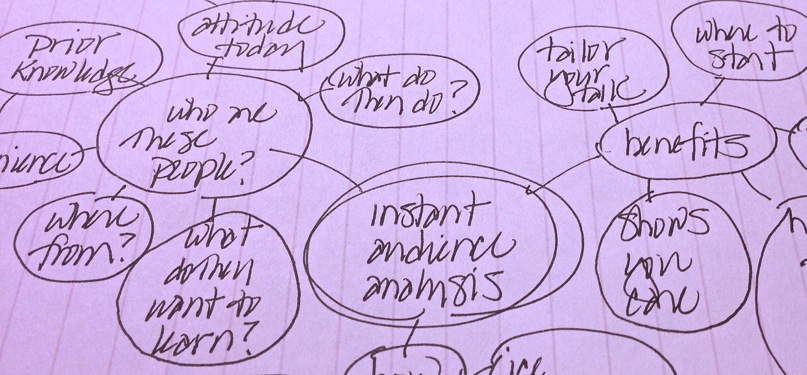If you give presentations, one day, despite your best efforts, you’ll find yourself talking to a room full of people without knowing much about them.

What could go wrong?
Everyone has seen the train wreck that results when a speaker completely misjudges the audience. Let’s not do that.
Here’s what to avoid:
- Starting too high—your talk is above their heads—and they can’t catch up.
- Heading down the wrong track—almost the right topic, but not quite—and they don’t want to go that way.
- Covering ground they’ve already traveled—your talk is too basic—and they zone out.
Once Upon a Time (True Story)
I’m designing a communications offsite for a group of VPs at a Fortune 500 company. They want to “communicate better.” I don’t know them, and I won’t have a chance to interact with or observe them before the offsite. When asked how they are communicating today, my client says, “It’s bad.”
This is a little bit frightening, because…
Fuzzy Topic. “Communication” is a big squishy topic, but to narrow it down a bit, my client asks me to use the principles outlined in a specific book. Okay, content problem sort of solved.
Fuzzy Goal. What do they want to achieve? “Better communication.” Any improvement is welcome. (I work with my client to clarify this.)
Undefined Audience. One of the first rules of speaking or training is, “Know Your Audience.” That’s not happening ahead of time in this case.
However, my client is counting on me, so I forge ahead…
The Solution. I create a flexible agenda that starts with an instant audience analysis. At the beginning of the event I ask questions to learn more about my participants. Based on their responses, I adjust the agenda on the spot.
The Result. Everything goes well! Excellent feedback, obvious progress made by the group. Happy client.
How You Can Use Instant Audience Analysis
To meet an unfamiliar audience where they are, follow these four steps:
- Before the event, create a flexible agenda that starts out easy and builds.Think about your topic in small chunks. What’s the most basic chunk of content that your audience might find beneficial? That’s your first possible starting point.
Add ever-more-advanced content until you reach the furthest point you think they can possibly travel in the time you have with them. Now you’re prepared if they have a lot of knowledge to start with or if they just learn quickly.
- Start with diagnostic questions about the topic. For example:How many of you have ever…? (You’re looking for education or experience with this kind of question.)
What would you do if this happened? (Now you’re looking for expertise. You can tell a lot by the quality of their answers.)
- Use their answers to gauge where they are (and where they are not).
- Pick the agenda items that most closely match their location, and start there. Keep checking in with your participants so that you can travel together to their best destination for now.
I try to use some form of this every time I’m in front of people. Even if you know quite a lot about the audience, it’s helpful to find out how they are doing at the moment you are together.
You can work with people in a helpful way, even if you don’t know much about them when you start your talk. You can use instant audience analysis for any presentations or training programs (in person or at a distance) where you can get responses from your participants. If you meet them where they are, they’ll be able to hear your message and learn something new. Besides, they’ll love you for it.
Question
Instant audience analysis is just one of many ways you can connect with your audience. What do you do to get to know your audience?
